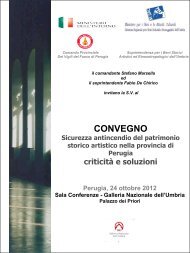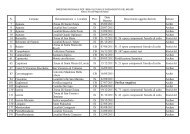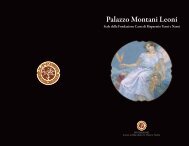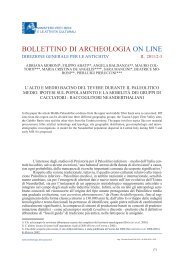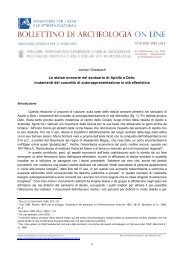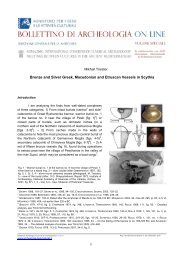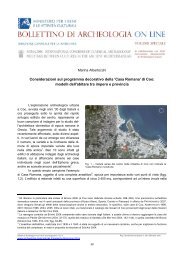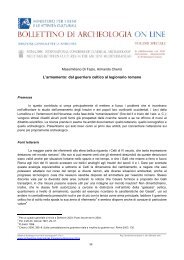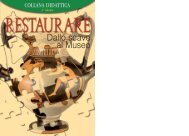Late Hellenistic Settlements in Hawrān (Southern Syria). Survival of ...
Late Hellenistic Settlements in Hawrān (Southern Syria). Survival of ...
Late Hellenistic Settlements in Hawrān (Southern Syria). Survival of ...
Create successful ePaper yourself
Turn your PDF publications into a flip-book with our unique Google optimized e-Paper software.
XVII International Congress <strong>of</strong> Classical Archaeology, Roma 22-26 Sept. 2008<br />
Session: Formation d’une culture urba<strong>in</strong>e aux marges du désert syro-arabique: espaces urba<strong>in</strong>s et périurba<strong>in</strong>s<br />
ma<strong>in</strong>ly on pastoralism. Part <strong>of</strong> their <strong>in</strong>habitants may have practiced tree cultivation <strong>in</strong> the neighbour<strong>in</strong>g area,<br />
or cereal culture <strong>in</strong> small distant parcels, but these were probably secondary activities 41 .<br />
Around Tell Jubeh, the slopes <strong>of</strong> the volcano bear the traces <strong>of</strong> ancient - though undated - terrace<br />
cultivation. Many collapsed terrace walls visible. The bottom <strong>of</strong> the small valley which the site overlooks<br />
comprises today small parcels <strong>of</strong> olive trees. However, the wide central courtyard, which is devoid <strong>of</strong><br />
constructions, is hardly understandable if not for keep<strong>in</strong>g livestock. The central birkeh was probably dug <strong>in</strong><br />
order provide water for the herds. Indeed, the water <strong>of</strong> such open air reservoirs is not suitable for human<br />
use. The economy <strong>of</strong> this settlement probably <strong>in</strong>cluded an prom<strong>in</strong>ent pastoral component, maybe comb<strong>in</strong>ed<br />
with tree cultivation.<br />
Though agropastoral, these newly created settlements do not necessarily result from the<br />
sedentarization <strong>of</strong> nomads. On the fr<strong>in</strong>ge <strong>of</strong> the sedentary zone, many rural communities are mobile, either<br />
partially (through a segmentation <strong>of</strong> the group) or totally (through yearly movements <strong>of</strong> transhumance) 42 . In<br />
Iron Age enclosed settlements <strong>of</strong> Palest<strong>in</strong>e and Transjordan - which <strong>of</strong>fer the closest parallels to the sites<br />
under <strong>in</strong>vestigation - the “sedentariz<strong>in</strong>g nomads” model is highly debated 43 . In the <strong>Hellenistic</strong> and Roman<br />
times, there is virtually no evidence for the presence <strong>of</strong> real nomads <strong>in</strong> Hawrân. As stressed by M.<br />
MacDonald, only a very marg<strong>in</strong>al number <strong>of</strong> “Safaitic” <strong>in</strong>scriptions were found <strong>in</strong> Hawrân, which suggests that<br />
the region did not belong to the transhumance area <strong>of</strong> the so-called “Safaitic” nomads 44 . Besides, the fact<br />
that no such <strong>in</strong>scriptions have been found <strong>in</strong>side the ancient villages makes it very unlikely that these<br />
nomads ever sedentarized <strong>in</strong> Hawrân. On the other hand, Zeno’s papyri and the book <strong>of</strong> the Maccabees<br />
mention Nabataean tribes graz<strong>in</strong>g or trad<strong>in</strong>g on the southern plateaus <strong>of</strong> the region <strong>in</strong> the 3 rd and 2 nd c. BC 45 .<br />
However, the latter text clearly dist<strong>in</strong>guishes the Nabataeans from the local population, and several pieces <strong>of</strong><br />
evidence (onomastics, material culture, cults) make it clear that the northern part <strong>of</strong> the region was neither<br />
settled nor politically dom<strong>in</strong>ated by the Nabataeans 46 . It is probable that even <strong>in</strong> the southern part, only<br />
Bosra, the regional capital, had a significant Nabataean population 47 . Most semitic <strong>in</strong>scriptions <strong>of</strong> northern<br />
Jebel al-‘Arab are written <strong>in</strong> local Aramaic, not <strong>in</strong> Nabataean 48 .<br />
Therefore, it is more cautious to th<strong>in</strong>k <strong>of</strong> these groups as new communities rather as sedentariz<strong>in</strong>g<br />
nomadic groups. This may be confirmed by the absence <strong>of</strong> any obvious k<strong>in</strong>ship-based organisation <strong>in</strong> Tell<br />
Jubeh, probably the best preserved settlement among those discussed here. This site is characterized by a<br />
uniform distribution <strong>of</strong> dist<strong>in</strong>ct s<strong>in</strong>gle casemate-like houses. Most houses have an <strong>in</strong>dependent door and<br />
open directly on the common central area (fig. 4). There are two clusters <strong>of</strong> rooms on the high citadels, but<br />
given their position they are better <strong>in</strong>terpreted <strong>in</strong> hierarchical (“palaces”) or functional (strongholds, fortified<br />
storage areas) terms. Here, the basic organizational unit seems to be that <strong>of</strong> the house, not that <strong>of</strong> larger<br />
k<strong>in</strong>ship groups. This is quite consistent with the hypothesis <strong>of</strong> a new community founded through the<br />
recruitment <strong>of</strong> displaced <strong>in</strong>dividuals or families.<br />
41 In some villages <strong>of</strong> Leja, there are still some semi-nomadic families, who cultivate small parcels <strong>of</strong> land and practice a six-month<br />
transhumance to the fertile plateaus <strong>of</strong> Jedur <strong>in</strong> summer (<strong>in</strong>terview with the Sâleh family <strong>in</strong> Sûr al-Leja, 15/05/2006). See also GUÉRIN<br />
2000.<br />
42 See MARFOE 1979 for examples <strong>of</strong> such phenomena <strong>in</strong> the pla<strong>in</strong> <strong>of</strong> Biq‘ <strong>in</strong> Lebanon.<br />
43 This model has been proposed by I. F<strong>in</strong>kelste<strong>in</strong> for the “enclosed settlements” <strong>of</strong> the Judean Highlands and the Negev (FINKELSTEIN<br />
1988 and 1995). His argumentation rests on the ecologically marg<strong>in</strong>al location <strong>of</strong> the sites, and on an architectural parallelism with some<br />
Bedou<strong>in</strong> camps <strong>of</strong> the early 20 th c. <strong>in</strong> the Negev desert. This model has been challenged by B. Routledge, who favours a dynamic <strong>of</strong><br />
“recruitment and attachment <strong>of</strong> displaced <strong>in</strong>dividual, families, and/or l<strong>in</strong>eages, regardless <strong>of</strong> their prior mode <strong>of</strong> production” (ROUTLEDGE<br />
2000, 60; 2004). Routledge criticizes the equation between pastoralism and nomadic orig<strong>in</strong>, and underl<strong>in</strong>es the fact that most<br />
ethnographically attested villages <strong>of</strong> sedentarized Bedou<strong>in</strong>s are unwalled and dispersed settlements.<br />
44 MCDONALD 1993.<br />
45<br />
DURAND 1997, n° 27.<br />
46<br />
VILLENEUVE 1985, 73–75.<br />
47<br />
SARTRE 1982.<br />
48<br />
STARCKY 1985, 173.<br />
Bollett<strong>in</strong>o di Archeologia on l<strong>in</strong>e I 2010/ Volume speciale G / G5 / 2 Reg. Tribunale Roma 05.08.2010 n. 330 ISSN 2039 - 0076<br />
www.archeologia.beniculturali.it<br />
9



